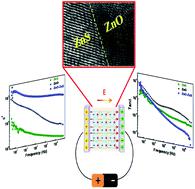Our official English website, www.x-mol.net, welcomes your
feedback! (Note: you will need to create a separate account there.)
Frequency stable dielectric constant with reduced dielectric loss of one-dimensional ZnO–ZnS heterostructures
Nanoscale ( IF 5.8 ) Pub Date : 2021-09-16 , DOI: 10.1039/d1nr03136h Amina Zafar 1, 2 , Muhammad Younas 3 , Syeda Arooj Fatima 4 , Lizhi Qian 5 , Yanguo Liu 5 , Hongyu Sun 5 , Rubina Shaheen 4 , Amjad Nisar 1 , Shafqat Karim 1 , Muhammad Nadeem 3 , Mashkoor Ahmad 1
Nanoscale ( IF 5.8 ) Pub Date : 2021-09-16 , DOI: 10.1039/d1nr03136h Amina Zafar 1, 2 , Muhammad Younas 3 , Syeda Arooj Fatima 4 , Lizhi Qian 5 , Yanguo Liu 5 , Hongyu Sun 5 , Rubina Shaheen 4 , Amjad Nisar 1 , Shafqat Karim 1 , Muhammad Nadeem 3 , Mashkoor Ahmad 1
Affiliation

|
The synthesis of one-dimensional heterostructures having high dielectric constant and low dielectric loss has remained a great challenge. Until now, the dielectric performance of ZnO–ZnS heterostructures was scarcely investigated. In this work, large-scale ZnO–ZnS heterostructures were synthesized by employing the chemical vapor deposition method. High resolution transmission electron microscopy (HRTEM) confirms the formation of heterostructures. X-ray photoelectron spectroscopy (XPS) shows that S atoms fill up the oxygen vacancy (VO) in ZnO, leading to the suppression of charge carrier's movement from ZnO to ZnS; instead there is charge transfer from ZnS to ZnO. Conductivity mismatch between adjacent ZnO and ZnS materials leads to the accumulation of free charges at the interface of the heterostructure and can be considered as a capacitor-like structure. The electrical behaviors of the potential phases of ZnO, ZnS and the ZnO–ZnS heterostructure are well interpreted by a best fitted equivalent circuit model. Each heterostructure acts as a polarization node with a specific flip-flop frequency and all such nodes form continuous transmission of polarization, which jointly increase the dielectric energy-storage performance. The orientational polarization of the polarons and Zn2+–VO dipoles present at the heterostructure interface contributes to the frequency stable dielectric constant at ≥103 Hz. Our findings provide a systematic approach to tailor the electronic transport and dielectric properties at the interface of the heterostructure. We suggest that this approach can be extended for improving the energy harvesting, transformation and storage capabilities of the nanostructures for the development of high-performance energy-storage devices.
中文翻译:

一维ZnO-ZnS异质结构介电损耗降低的频率稳定介电常数
具有高介电常数和低介电损耗的一维异质结构的合成仍然是一个巨大的挑战。到目前为止,几乎没有研究 ZnO-ZnS 异质结构的介电性能。在这项工作中,采用化学气相沉积方法合成了大规模的 ZnO-ZnS 异质结构。高分辨率透射电子显微镜 (HRTEM) 证实了异质结构的形成。X 射线光电子能谱 (XPS) 显示 S 原子填补了氧空位 (V O) 在 ZnO 中,导致电荷载流子从 ZnO 到 ZnS 的运动受到抑制;相反,电荷从 ZnS 转移到 ZnO。相邻的 ZnO 和 ZnS 材料之间的电导率不匹配导致异质结构界面处自由电荷的积累,可以认为是一种类似电容器的结构。ZnO、ZnS 和 ZnO-ZnS 异质结构的电位相的电学行为可以通过最佳拟合等效电路模型得到很好的解释。每个异质结构充当具有特定触发器频率的极化节点,所有这些节点形成极化的连续传输,共同提高了介电储能性能。极化子和 Zn 2+ –V O的取向极化异质结构界面处的偶极子有助于频率稳定的介电常数≥10 3 Hz。我们的研究结果提供了一种系统方法来定制异质结构界面处的电子传输和介电特性。我们建议可以扩展这种方法以提高纳米结构的能量收集、转换和存储能力,以开发高性能储能设备。
更新日期:2021-09-16
中文翻译:

一维ZnO-ZnS异质结构介电损耗降低的频率稳定介电常数
具有高介电常数和低介电损耗的一维异质结构的合成仍然是一个巨大的挑战。到目前为止,几乎没有研究 ZnO-ZnS 异质结构的介电性能。在这项工作中,采用化学气相沉积方法合成了大规模的 ZnO-ZnS 异质结构。高分辨率透射电子显微镜 (HRTEM) 证实了异质结构的形成。X 射线光电子能谱 (XPS) 显示 S 原子填补了氧空位 (V O) 在 ZnO 中,导致电荷载流子从 ZnO 到 ZnS 的运动受到抑制;相反,电荷从 ZnS 转移到 ZnO。相邻的 ZnO 和 ZnS 材料之间的电导率不匹配导致异质结构界面处自由电荷的积累,可以认为是一种类似电容器的结构。ZnO、ZnS 和 ZnO-ZnS 异质结构的电位相的电学行为可以通过最佳拟合等效电路模型得到很好的解释。每个异质结构充当具有特定触发器频率的极化节点,所有这些节点形成极化的连续传输,共同提高了介电储能性能。极化子和 Zn 2+ –V O的取向极化异质结构界面处的偶极子有助于频率稳定的介电常数≥10 3 Hz。我们的研究结果提供了一种系统方法来定制异质结构界面处的电子传输和介电特性。我们建议可以扩展这种方法以提高纳米结构的能量收集、转换和存储能力,以开发高性能储能设备。











































 京公网安备 11010802027423号
京公网安备 11010802027423号